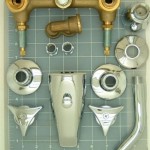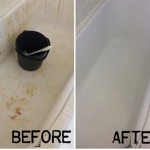What to Use to Clean a Bathtub: A Comprehensive Guide
Maintaining a clean bathtub is crucial for both hygiene and aesthetics. A grimy bathtub can harbor bacteria and mold, posing potential health risks. Regular cleaning prevents the build-up of soap scum, hard water stains, and other unpleasant residues, prolonging the lifespan of the bathtub and ensuring a pleasant bathing experience. Selecting the appropriate cleaning agents and methods is paramount to achieving a sparkling clean bathtub without damaging its surface.
The optimal cleaning solution depends on the material of the bathtub and the type of stains present. Various cleaning agents, ranging from readily available household items to specialized commercial products, can effectively restore a bathtub's cleanliness. This article systematically outlines suitable cleaning methods and agents for different bathtub scenarios.
Understanding Bathtub Materials
Before embarking on the cleaning process, identifying the material of the bathtub is critical. Common bathtub materials include acrylic, porcelain (often coated over cast iron or steel), fiberglass, and enamel. Each material reacts differently to various cleaning agents. Using an inappropriate cleaner can lead to scratches, discoloration, or even structural damage.
Acrylic bathtubs are known for their durability and relatively smooth, non-porous surfaces. They are generally resistant to scratches and stains but can be susceptible to damage from abrasive cleaners and harsh chemicals.
Porcelain bathtubs, typically found over cast iron or steel, are sturdy and heat-retentive. However, porcelain can chip or crack, exposing the underlying metal to rust. Porcelain is generally resistant to most cleaning agents but should be protected from harsh abrasives.
Fiberglass bathtubs are lightweight and relatively inexpensive. They are more prone to scratches and stains compared to acrylic and porcelain. Harsh chemicals and abrasive cleaners should be avoided to preserve the surface finish.
Enamel bathtubs, often found over cast iron, offer a classic look. They are susceptible to chipping and staining, especially from acidic substances. Gentle cleaning methods are recommended.
Household Cleaning Agents: Everyday Solutions
Many effective bathtub cleaning solutions can be found within the average household. These options are often cost-effective and environmentally friendly, providing a safer alternative to harsh chemical cleaners. However, testing any solution on an inconspicuous area of the bathtub before applying it to the entire surface is always recommended.
Baking Soda and Vinegar: This classic combination provides a powerful and natural cleaning action. Sprinkle baking soda generously over the damp bathtub surface. Then, spray or pour white vinegar onto the baking soda. The mixture will fizz, creating a mild abrasive and loosening grime. Allow the mixture to sit for approximately 20-30 minutes before scrubbing with a non-abrasive sponge or brush and rinsing thoroughly with water. This is effective for soap scum and hard water stains.
Lemon Juice: The citric acid in lemon juice makes it an effective stain remover and disinfectant. Cut a lemon in half and rub it directly onto the stained areas. Alternatively, squeeze lemon juice onto a sponge and apply it to the bathtub surface. Allow the lemon juice to sit for approximately 30 minutes before scrubbing and rinsing. Lemon juice is particularly effective for removing hard water stains and rust stains. It also leaves a fresh, clean scent.
Dish Soap: Mild dish soap can be surprisingly effective for general cleaning and removing soap scum. Mix a small amount of dish soap with warm water and apply it to the bathtub surface with a sponge or cloth. Scrub gently and rinse thoroughly. Dish soap is a gentle option suitable for all bathtub materials.
Hydrogen Peroxide: Hydrogen peroxide is a mild disinfectant and bleaching agent that can help remove stains and kill bacteria. Spray hydrogen peroxide onto the stained areas and allow it to sit for approximately 30 minutes before scrubbing and rinsing. Hydrogen peroxide is particularly effective for removing mildew and mold stains. Exercise caution when using hydrogen peroxide on colored bathtubs, as it may cause slight fading.
Cream of Tartar: Cream of tartar is a mild abrasive that can be used to remove stains and polish surfaces. Mix cream of tartar with a small amount of water to form a paste. Apply the paste to the stained areas and rub gently with a soft cloth or sponge. Rinse thoroughly. Cream of tartar is effective for removing stubborn stains and polishing porcelain or enamel surfaces.
Commercial Cleaning Products: Addressing Stubborn Stains
For particularly stubborn stains or heavy build-up of grime, commercial cleaning products might be necessary. Always carefully read and follow the manufacturer's instructions when using these products, and ensure adequate ventilation. Wear gloves to protect the skin from chemical exposure.
Non-Abrasive Bathroom Cleaners: Choose a bathroom cleaner specifically designed for the bathtub material. These cleaners typically contain surfactants and solvents that dissolve soap scum, hard water stains, and other grime. Follow the instructions on the product label, applying the cleaner to the surface, allowing it to sit for the recommended time, scrubbing, and rinsing thoroughly. These are generally safe for regular use on acrylic, fiberglass, and porcelain tubs.
Mildew and Mold Removers: For bathtubs prone to mildew and mold growth, specialized mildew and mold removers are available. These products usually contain bleach or other disinfecting agents. Apply the product according to the manufacturer's instructions, paying close attention to ventilation guidelines. Remember to rinse thoroughly after application. Prevention is key to limiting future growth, so address ventilation issues and wipe down the tub after each use.
Hard Water Stain Removers: Hard water stains, caused by mineral deposits in water, can be challenging to remove. Commercial hard water stain removers often contain acids that dissolve the mineral deposits. Follow the instructions carefully, and test the product on an inconspicuous area first, as some acid-based cleaners can damage certain bathtub materials. Look for products that are specifically designed for use on bathtubs.
Soap Scum Removers: Soap scum can build up over time and create a dull film on the bathtub. Soap scum removers contain detergents and solvents that break down the soap scum. Apply the product according to the manufacturer's instructions and rinse thoroughly. Regular use of soap scum removers can help prevent build-up and make cleaning easier.
Rust Stain Removers: Rust stains can be caused by metal objects left in the bathtub or by rust in the plumbing. Rust stain removers often contain acids or chelating agents that dissolve the rust. Apply the product according to the manufacturer's instructions and rinse thoroughly. Exercise caution when using rust stain removers on colored bathtubs, as they may cause discoloration.
Effective Cleaning Techniques: Maximizing Results
The effectiveness of any cleaning agent is enhanced by proper cleaning techniques. Using the right tools and methods can significantly improve the results and minimize the risk of damage to the bathtub.
Choosing the Right Tools: Use non-abrasive sponges, microfiber cloths, or soft-bristled brushes to avoid scratching the bathtub surface. Avoid using steel wool or abrasive scouring pads, as these can cause permanent damage. For hard-to-reach areas, such as corners and crevices, use an old toothbrush or a grout brush.
Proper Scrubbing Techniques: Use gentle, circular motions when scrubbing the bathtub. Avoid applying excessive pressure, as this can damage the surface. For stubborn stains, allow the cleaning agent to sit for a longer period before scrubbing. Rinse thoroughly after scrubbing to remove any residue.
Rinsing Thoroughly: Thorough rinsing is essential to remove all traces of the cleaning agent. Residue left on the bathtub surface can attract dirt and grime, leading to faster build-up of stains. Use warm water and rinse until the water runs clear. Wipe down the bathtub with a clean, dry cloth to prevent water spots.
Regular Cleaning Schedule: Implementing a regular cleaning schedule is crucial for preventing the build-up of stains and grime. Cleaning the bathtub at least once a week can significantly reduce the effort required and maintain its cleanliness. Wiping down the bathtub after each use can further minimize the build-up of soap scum and water spots. Consider using a squeegee after showering to remove excess water from the walls and tub.
Preventative Measures: Preventing future stains is often easier than removing existing ones. Consider using a water softener to reduce hard water stains. Always rinse soap and shampoo residue thoroughly after each use. Regularly ventilate the bathroom to reduce humidity and prevent mildew growth. Consider using a bathtub mat or liner to protect the bathtub surface.
Maintaining a clean bathtub is an ongoing process that requires the right cleaning agents, techniques, and a consistent cleaning schedule. By understanding the bathtub material and selecting appropriate cleaning methods, anyone can keep their bathtub sparkling clean and hygienic.

How To Clean A Bathtub The Right Way 9 Easy Steps Follow Trusted Since 1922

How To Clean A Bathtub Deep And After Each Use

What To Use Safely Clean Your Refinished Tub Todd S Bathtubs

Baking Soda Bleach And Vinegar Which Is Best For A Clean Bathtub 2024

How To Clean A Bathtub Pro Housekeepers
Best Bathtub Cleaners Of 2024

How To Clean A Bathtub With Dish Soap And Broom Taste Of Home

How To Clean A Dirty Tub Quickly

This Weird Trick Is The Best Way To Clean Your Bathtub

3 Ways To Clean A Bathtub With Bleach Wikihow
Related Posts








